Overview
Identification number: 2016.165
Artist: Pier Francesco di Jacopo Foschi
Title: St. Philip Benizzi and the Gamblers
Materials: Oil (untested) on marouflaged wood panel
Date of creation: About 1535–1540
Previous number/accession number: C10072
Dimensions:
61 × 16.5 × 1.9 cm (with edge strips and cradle)
58.2 × 13.9 (original panel)
Conservator/examiner: Fiona Beckett and Roxane Sperber
Examination completed: 2014, revised 2020
Distinguishing Marks
Front:
None
Back:
Item 1. Handwritten in pencil, uppermost cradle member: “TR10072” (tech. fig. 1).

Summary of Treatment History
Prior to its arrival at the IMA, the painting underwent several significant interventions. The long, rectangular shape of the panel suggests it may have been part of a predella for an altarpiece. If this is the case, the panel would have been cut from its original construction and reconfigured to serve as an easel painting. Structurally the painting appears to have had a panel-to-panel transfer where the original support was removed, and the paint layer, ground, and possibly some of the original wood support were adhered to a new panel. The new panel was marouflaged to a secondary veneer to which a cradle was attached. Wood strips were also added to the front of the painting to frame the edges of the painted area. There is also evidence that the painting underwent varnish removal (likely several times), and retouching is visible on the surface.
Documentation suggests a series of condition assessments and treatments were carried out on the collection at about the time the works were moved from the Clowes residence to the IMA in 1971. A condition report by Paul Spheeris in October of that year, likely carried out before the paintings were relocated, described the painting as “O.K.” He recommended no treatment be undertaken.1 A second condition assessment was carried out upon arrival of the paintings at the IMA. This assessment describes the work as being in good condition, and no work was deemed necessary.2
The condition of the painting was examined and documented in Clowes Collection annual survey from 2011 to 2020.
Current Condition Summary
Aesthetically, the painting is in relatively good condition, with a few minor areas of discolored, old retouching and varnish. Structurally, the painting is sound.
Methods of Examination, Imaging, and Analysis
| Examination/Imaging | Analysis (no sample required) | Analysis (sample required) |
|---|---|---|
| Unaided eye | Dendrochronology | Microchemical analysis |
| Optical microscopy | Wood identification | Fiber ID |
| Incident light | Microchemical analysis | Cross-section sampling |
| Raking light | Thread count analysis | Dispersed pigment sample |
| Reflected/specular light | X-ray fluorescence spectroscopy (XRF) | Fourier-transform infrared spectroscopy (FTIR) |
| Transmitted light | Macro X-ray fluorescence scanning (MA-XRF) | Raman microspectroscopy |
| Ultraviolet-induced visible fluorescence (UV) | ||
| Infrared reflectography (IRR) | Gas chromatography–mass spectrometry (GC-MS) | |
| Infrared transmittography (IRT) | Scanning electron microscope-energy dispersive X-ray spectroscopy (SEM-EDS) | |
| Infrared luminescence | Other: | |
| X-radiography |
Technical Examination
Description of Support
Analyzed Observed
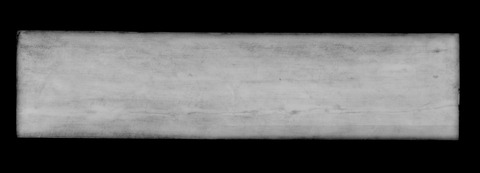
Material (fabric, wood, metal, dendrochronology results, fiber ID information, etc.):
Wood, with grain in the horizontal orientation (tech. fig. 2). The type of wood is unknown, and the original panel cannot be accessed in the painting’s current configuration.
Characteristics of Construction / Fabrication (cusping, beveled edges of panels, seams, joins, battens):
The panel appears to have been constructed from a single piece of wood that was likely part of a predella for a church in Pisa. However, the painting appears to have undergone significant structural intervention and may have been transferred to a secondary panel support. A veneer has been applied to the back of the panel, and a cradle was attached to the veneer. Wood strips are also present along the edges of the painting, making it difficult to assess the original construction of the panel.
A fabric, closely resembling linen, is visible along the edges of the panel and extends beyond the edge of the original paint layer (tech. fig. 3). This fabric layer is consistent with traditional Italian panel painting practices, in which a canvas would be applied over the wood panel before the application of the ground layer. This fabric layer appears along the edge in several areas but is not visible in the X-radiograph.
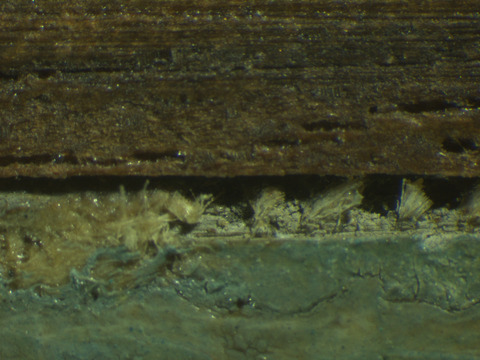
Curiously, an evenly woven, mesh-like fabric is visible in the X-radiograph (tech. fig. 4). The fabric has a plain weave but was applied to the panel on a diagonal axis. The thread count of the fabric is approximately nine threads/cm, the interstices are spacious, and the overlapping fibers appear to be fused at their meeting points. These characteristics are not consistent with the linen fabric that is visible at the edge of the panel, which suggests that the mesh-like fabric is not original but was added when the painting was transferred a new panel. The mesh-like fabric may have been adhered to the back before transfer, though more analysis is necessary.
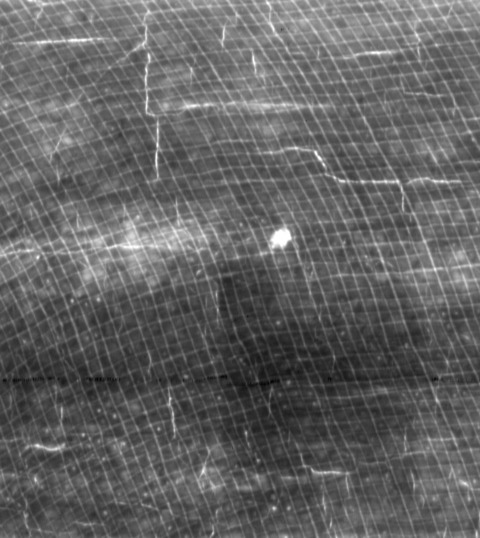
A gray putty present around the edges of the panel appears to have been applied to the back during the transfer process. This material was analyzed using Raman microspectroscopy and found to contain lead white mixed with manganese oxide black. This X-ray-dense material used in the transfer process may explain the overall radiopaque nature of the X-radiograph. The lead putty was probably applied to help facilitate the adhesion of the original paint layer to the new panel during the transfer.
Thickness (for panels or boards):
Approximately 0.7 cm (including attached additional panel); 2.6 cm (including cradle).
Production/Dealer’s marks:
None
Auxiliary Support:
Original Not original Not able to discern None
Attachment to Auxiliary Support:
A thin wooden veneer backing has been added to the nonoriginal panel support. A cradle is adhered to the veneer backing. The cradle has four horizontal members that are glued in place. There are five sliding, vertical cradle members. Edge strips have also been added to frame the edges of the painting.
Condition of Support
The auxiliary support is in good condition; all vertical cradle members remain moveable, indicating that the panel has not reacted to environmental extremes and has been maintained in a stable environment since the application of the cradle. The panel suffered some damage in the past. Previous warping and movement of the panel resulted in significant cracks along the wood grain and subsequently the ground layer. This can be observed in the X-radiograph (tech. fig. 2). One split runs the entire length of the panel. These structural problems may have prompted the panel transfer and addition of the cradle.
Description of Ground
Analyzed Observed
Materials/Binding Medium:
A cross-section sample taken from the area of the sky (tech. fig. 5) was analyzed using SEM-EDS analysis. The ground layer is composed of calcium sulfate (tech. figs. 6, 7) with the addition of some iron oxide (earth pigments) (tech. fig. 8).

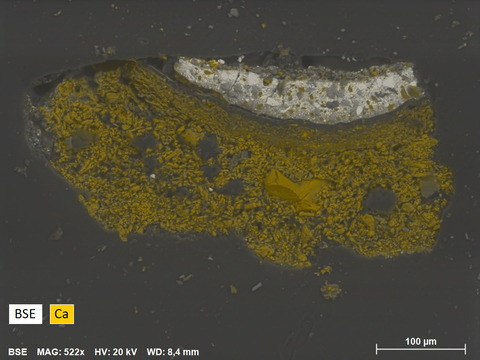
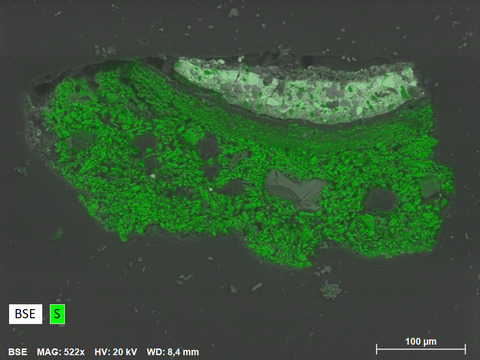
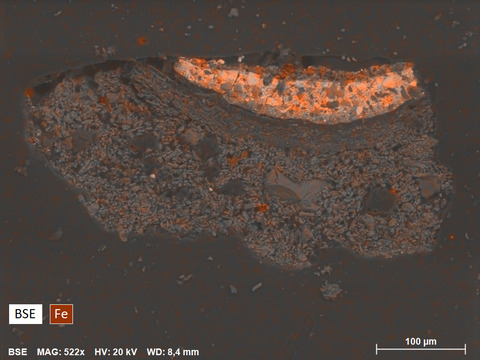
Color:
The ground layer is white.
Application:
The gesso was likely brushed onto the uppermost layer of the original panel vertically, as the direction of the brush marks can be seen in the infrared image. The ground appears to have been applied in two layers. A more coarsely ground (gesso grosso) layer (tech. fig. 5, layer 1) was applied first, followed by a more finely ground (gesso sottile) layer (tech. fig. 5, layer 2). The texture differential is visible in the BSE image of the ground layer (tech. fig. 9).
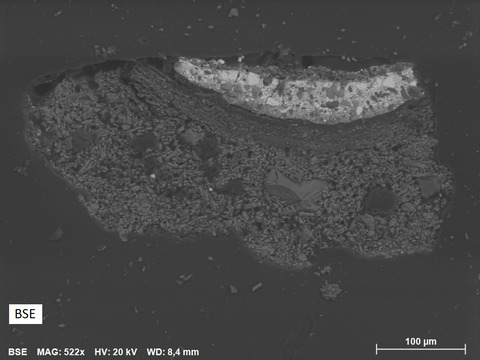
Thickness:
The first layer of ground was applied quite thickly, measuring approximately 110 µm. The second layer of ground was applied thinly, measuring approximately 30 µm (tech. fig. 9).
Sizing:
While not clearly visible in cross section, animal-glue size would have been incorporated in the gesso layer, and possibly also on the original panel and the subsequent transfer panel.
Character and Appearance (does texture of support remain detectable / prominent?):
The wood grain and canvas textures are not visible through the ground layer. The cracking pattern is also only slightly visible and not characteristic of the support. In the enhanced X-radiograph, the craquelure pattern in the ground layer is more visible and resembles that characteristic of wood grain.
Condition of Ground
Where visible, the ground appears to be in stable condition. There are several areas of cracking that are visible when imaged with X-radiography (tech. fig. 2). One split runs the entire length of the panel, affecting the ground layer in this area. The split was repaired and filled. This is visible with infrared imaging (tech. fig. 10). No recent cracking or damage to the ground layer is visible.
Description of Composition Planning
Methods of Analysis:
Surface observation (unaided or with magnification)
Infrared reflectography (IRR)
X-radiography3
Analysis Parameters:
| X-radiography equipment | GE Inspection Technologies Type: ERESCO 200MFR 3.1, Tube S/N: MIR 201E 58-2812, EN 12543: 1.0mm, Filter: 0.8mm Be + 2mm Al |
|---|---|
| KV: | 26 |
| mA: | 3 |
| Exposure time (s) | 90 |
| Distance from X-ray tube: | 36″ |
| IRR equipment and wavelength | Opus Instruments Osiris A1 infrared camera with InGaAs array detector operating at a wavelength of 0.9-1.7µm. |

Medium/Technique:
The underdrawing appears to be composed of a dry medium containing carbon.
Some underdrawing is visible when the painting is examined using infrared reflectography (tech. fig. 10). The figures are lightly outlined in tentative, rounded lines (tech. fig. 11), outlining their underlying musculature and overlying attire. It appears the underdrawing was done in a dry medium. The large split to the panel can also be seen in infrared reflectography, showing its severity and disruption to the composition.
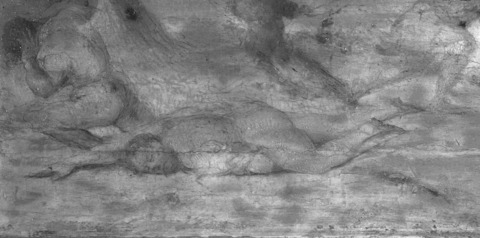
Pentimenti:
No significant alterations are visible is the underdrawing. The artist refined the underdrawing during the painting stage, covering some of the drawing and continuing to outline with the paint.
Description of Paint
Analyzed Observed
Application and Technique:
The paint was applied conservatively with brushes. Paint blending and sfumato were used in the background. The figures are rendered carefully, and a limited palette was used. The paint was applied in a paste-vehicular consistency.
Painting Tools:
Brushes of varying sizes appear to have been used in the small painting. There is no evidence that a palette knife or other hard-edged tool was used.
Binding Media:
The artist’s technique suggests the use of an oil medium, but this has not been confirmed through analysis.
Color Palette:
The color palette comprises simple colors set against a white background, with washes and glazes used to create a subtle, pastel-like background. XRF analysis detected the presence of copious amounts of lead (lead white), iron oxide (earth pigments), copper-containing green and/or blue pigments (including azurite), tin (lead-tin yellow), gold (flake gold or shell gold for the halos), as well as calcium from the gesso layers (see Description of Ground).
Cross section 1-1 from the area of the sky (tech. fig. 12) shows large blue particles in layer 3. When analyzed using SEM-EDS, these particles were found to contain copper, suggesting the presence of the pigment azurite in the sky (tech. fig. 13).

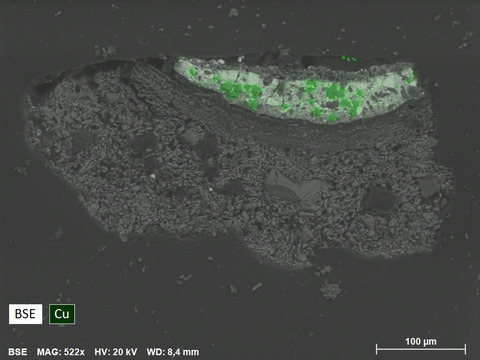
XRF Analysis:

| Sample | Location (x, y) | Elements | Pigments |
|---|---|---|---|
| 1 | Red pants (9.5,11.5) | Major: Pb, Fe, Ca Minor: Cu, Ti Trace: Mn, K | Lead white, iron oxide (earth pigments), calcium sulfate (from ground layer), copper-containing blue and/or green pigment, possible red lake pigments (not confirmed using XRF), titanium from impurity or possibly titanium white retouching. |
| 2 | Blue shirt (10.0, 5.0) | Major: Pb, Cu Minor: Ca Trace: Fe, Mn, Ti, K | Lead white, iron oxide (earth pigments), calcium sulfate (from ground layer), copper-containing blue and/or green pigment (likely azurite). |
| 3 | Yellow pants (12.0, 4.5) | Major: Pb, Fe Minor: Ca, Sn Trace: Mn, Ti | Lead white, lead-tin yellow, iron oxide (earth pigments), calcium sulfate (from ground layer). |
| 4 | Monk’s brown robe (30.0, 4.5) | Major: Pb Minor: Cu, Fe, Ca Trace: Mn | Lead white, iron oxide (earth pigments including umber), calcium sulfate (from ground layer), copper-containing blue and/or green pigment. |
| 5 | Gold halo (33.0, 13.5) | Major: Pb, Au Minor: Cu, Fe, Ca Trace: Sn | Lead white, shell gold, iron oxide (earth pigments), calcium sulfate (from ground layer), trace of lead-tin yellow. |
| 6 | White clouds (36.0, 9.5) | Major: Pb, Ti, Ca Minor: Trace: Fe, Mn, Zn | Lead white, titanium white (from retouching), iron oxide (earth pigments), calcium sulfate (from ground layer). |
Table 1: Results of X-ray fluorescence analysis conducted with a Bruker Artax microfocus XRF with rhodium tube, silicon-drift detector, and polycapillary focusing lens (~100μm spot).
*Major, minor, trace quantities are based on XRF signal strength not quantitative analysis
Surface Appearance:
The paint appears to be relatively thin, with no impasto. Some areas of old retouching are visible, particularly in the area where the panel split.
Condition of Paint
The paint layer is in good condition. Some small paint losses are scattered throughout the painting that are particularly visible under the microscope. These have been retouched. Some wear is visible around the perimeter of the painting where the original panel is surrounded by the edge strips. These areas of wear were also retouched.
Description of Varnish/Surface Coating
Analyzed Observed Documented
| Type of Varnish | Application |
|---|---|
| Natural resin | Spray applied |
| Synthetic resin/other | Brush applied |
| Multiple Layers observed | Undetermined |
| No coating detected |

Imaging under ultraviolet-induced visible fluorescence reveals the characteristic green fluorescence of a natural resin varnish across the entire surface of the painting (tech. fig. 15). In visible light, the painting appears to be slightly yellowed. Several campaigns of retouching are present from earlier conservation interventions, as well as that of a more recent inpainting campaign. This can be seen around the edges and in some parts of the composition. Due to the age of the natural resin, the fluorescence emitted by varnish under ultraviolet-induced visible fluorescence likely obscures some of the older restorations.
Condition of Varnish/Surface Coating
The varnish is slightly discolored, imparting a yellowish appearance, but is otherwise in good condition and adequately saturates the paint layers.
Description of Frame
Original/first frame
Period frame
Authenticity cannot be determined at this time/ further art historical research necessary
Reproduction frame (fabricated in the style of)
Replica frame (copy of an existing period frame)
Modern frame
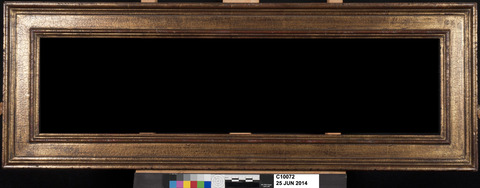
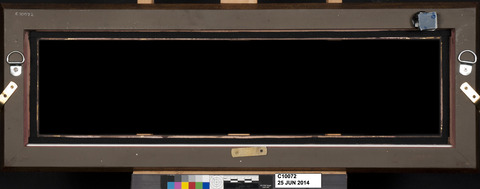
Frame Dimensions:
Outside frame dimensions: 24 × 68.3 cm
Sight size: 14 × 58 cm
Distinguishing Marks:
None
Description of Molding/Profile:
The frame is a simple cassetta-style, made from carved wood with surface gilding (tech. figs. 16, 17).
Condition of Frame
The frame is in relatively good condition.
Notes
-
Paul A.J. Spheeris, “Conservation Report on the Condition of the Clowes Collection,” 25 October 1971, Conservation Department Files, Indianapolis Museum of Art at Newfields. ↩︎
-
Martin Radecki, Clowes Collection condition assessment, undated (after October 1971), Conservation Department Files, Indianapolis Museum of Art at Newfields. ↩︎
-
Elvacite 2040 (synthetic resin) was used to fill the cradle while capturing the X-radiograph to minimize its appearance and allow the composition to be better interpreted. ↩︎
Additional Images







